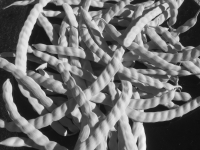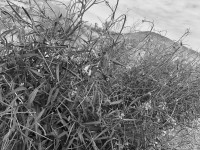Ephedra / Tutut

JUNE INGREDIENT: EPHEDRA OR TUTUT
This month we’ll be working with a rather eerily beautiful and common desert dweller, ephedra. If you’re familiar with this plant, you may know it by another name. But I’ll encourage you to forget that one and read this story. Even if you are not familiar with this plant, I think you should read this story:
I was attending the annual spring agave roast, a tradition of the native Cahuilla people that’s continued to this day at the Malki Museum on the Morongo reservation in Banning, CA. While talking to a highly revered cultural anthropologist and Malki board member, picking his brain about culinary and medicinal plants, I casually mentioned “Mormon tea.” His smile dissipated and he looked at me with a very grave brow. “Never call the ephedra plant Mormon tea.” I was really caught off guard and asked meekly, “why?” It was the most commonly used common name I had encountered when referring to the abundant stick-like plant that reigns alongside creosote bush and Joshua trees in our desert terrain—field guides use it, as do botanists and long-time desert dwellers, and all of my medicinal plant books also uses that label. “Because,” he matter-of-factly stated, “the Cahuilla used this plant to treat syphilis, gonorrhea, and other venereal disease—all of which were introduced by the Mormon or white settlers. Using that name displays a lack of respect and honors the colonial spirit.”
As a white woman and desert transplant—who additionally works with wild regional plants and draws heavily upon native traditions when researching their culinary aspects—this plant epitomizes my colonial conflict I try to tame. How can I respectfully work with the flora of this region without evoking the vestige of the rapacious European who has stolen and benefited from the oppressed? I get down about it, and sometimes think about just going back to commercially available plants in my cooking practice. But I was talking to a Joshua Tree herbalist the other day, and she too expressed similar insecurities, and simultaneously emphasized the importance of not losing the historical and cultural knowledge that has been practiced for centuries. To continue to work with these plants and remember their heritage is critical, and so is using the Cahuilla nomenclature.
By saying “Tutut,” you are reminded that you were not here first. You are not entitled to anything. That what you know is not born of your own genius, but a legacy that deserves to be acknowledged and honored only with the most honest, humble gratitude.
For more information on HDTK, as well as more information on ephedra/tutut, tips on how to identify it, and other nuggets of info, check out Sarah’s website.
Monday, June 18th at 7pm
Copper Mountain Mesa Community Center
65336 Winters Rd. Joshua Tree, CA
High Desert Test Kitchen (HDTK) is an informal monthly dinner gathering organized by artist Sarah Witt. Participants bring a dish to share that is either made with or inspired by ingredients inhabiting this peculiar span of the North American desert. Exploring the Mojave from a culinary perspective, HDTK naturally intersects with foraging practices and Native American traditions, and inevitably ignites debates concerning ethical human-to-wilderness relationships - hopefully challenging our taste buds too.
From September 2016 to July 2018 Sarah Witt organized High Desert Test Kitchen (HDTK), a monthly dinner gathering at the Copper Mountain Mesa Community Center in North Joshua Tree. Each month a different ingredient was featured with the challenge of incorporating local desert roots, fruits, insects, or a handful of twigs into a culinary repertoire. Participants would bring a dish to share, gathering together to discuss where the ingredients were sourced, the manner in which they were processed, and to consider their EQ (or edibility quotient). To read more about these native ingredients visit Sarah’s website.


















